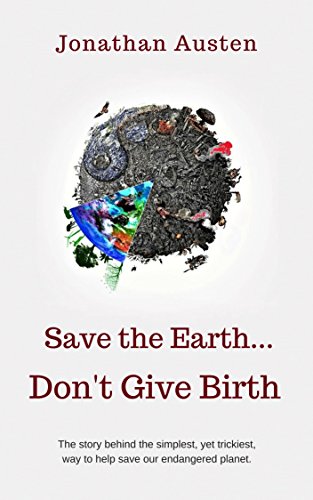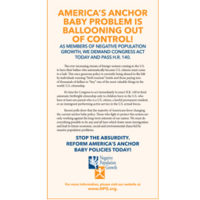Save the Earth…Don’t Give Birth (NPG Booknote)
- Edwin S. Rubenstein
- August 30, 2018
- Forum Papers
- Forum Paper
- 0 Comments
Save the Earth…Don’t Give Birth
The story behind the simplest, yet trickiest, way to help save our endangered planet.
by Jonathan Austen
An NPG Booknote
by Edwin Rubenstein

“We humans are young, greedy, inexperienced killer primates. We have recklessly allowed our population and consumption to rise beyond the capacity of the Earth. The rise in human populations is the underlying cause of the most pressing ecological disasters of today, yet almost all action to protect the ecosystem is focused on consumption only… Solely addressing consumption creates a conflict of interest where land is needed to both feed a growing population and to protect vulnerable species. Addressing population has no conflict of interest.”
– Don’t Give Birth, chapter 1, paragraph 1.
Intellectually, most Americans know there is a population problem. But for many of us, it’s a case of “out of sight, out of mind.” Life has never been better. We spend a smaller share of income on food and clothing, more on self-indulgent baubles, and a lot more educating our children. Declining fertility rates, technological breakthroughs, and the unrealized predictions of Malthus and other scare mongers, create the impression that we can forestall environmental collapse indefinitely.
Like the boy who cried wolf, Austen is desperate to capture our attention. He has mine: here are some of his pearls that stay with me:
The negative impact of population growth is slow and imperceptible compared to day-to-day changes in our financial, political, and personal lives. But once triggered, it quickly accelerates: “Historically, collapses have been rapid and unforeseen. According to Pulitzer-winning author Jared Diamond…one of the main lessons to be learned from the collapses of the Maya, Easter Islanders, and other past societies is that a steep decline may begin only a decade or two after the society reaches its peak in numbers, wealth, and power.” (p. 69)
We all suffer from PADD (Population Attention Deficit Disorder): “…Humans are programmed to respond to sudden danger, like realizing we’re about to fall off a chair or a cliff. The basic animal instinct doesn’t appear for long term issues like overpopulation and the environment. It’s even worse for overpopulation, as people increasing in numbers is barely news. What’s the danger there? We’re just people doing what people have always done…” (p.78)
Climate Change Awareness Loses, PC wins: “…We all know that every additional person will need to use some carbon energy, if only firewood for cooking and will therefore create more carbon dioxide…Yet not a word [on the nexus between population and climate change] appeared in the voluminous documents emerging from the Copenhagen and Cancun Climate Summits…There seems to be some bizarre taboo around the subject. ‘It’s not quite nice, not PC, possibly even racist to mention it’…The alternative is an increased death rate – the way in which all other creatures must suffer, through famine or disease or predation…” (p. 109-110.)
Species matter: “As habitats disappear, so do the species contained within them. We lose one species of animal or plant life every twenty minutes, or 27,000 species a year…Looked at in historical perspective, species often go extinct, but at the same time, new species are also constantly evolving through speciation, where species gradually change over time in different areas with differing conditions and eventually become genetically unique. Today, however, the rate of extinction far exceeds the rate of speciation…” (p.65.)
The human species is at risk: “The Global Footprint Network calculates ‘Earth Overshoot Day’ each year…the date when humanity’s demand for ecological resources and services exceeds what Earth can regenerate in that year. This deficit is maintained by drawing down stocks of ecological resources and accumulating waste – primarily CO-2 in the atmosphere.” (p. 66.)
Earth Overshoot Day occurs increasingly early: In 2000 it was November 1st; In 2008 it was September 23rd; In 2018 it was August 1st. Do the math, and you’ll see that we are accelerating our overshoot of global resources by about four days per year. At that rate, we’ll deplete our ecological margin in 2072. Something has to give.
Economists are Killing Us: Devastating floods have destroyed large swaths of major U.S. cities. Bridges have collapsed, roads and other public infrastructure are crumbling. These calamities are traceable, at least in part, to anthropogenic global warming and population growth. But each gives rise to new bursts of construction spending, pumping up GDP, enabling economists to congratulate themselves for being shrewd managers. Their collective blind side is captured best by the great University of Michigan economist Kenneth Boulding: “Anyone who believes in indefinite growth in anything physical, on a physically finite planet, is either mad or an economist.” (p. 82.)
Despite its apocalyptic title, this book is an easy, informative, and ultimately uplifting read for anyone interested in the ecological future of our planet. Governments may be paralyzed, but people are increasingly aware and engaged in the population issue. A tipping point is at hand, Austen says, “where it is normal, accepted, and commonplace to talk about our numbers.” (p. 121.)
Grass roots momentum will make it easier for politicians, moralists, and economists to speak candidly about the benefits of lower population. Ordinary citizens are not waiting, however. Birth rates are already down and “the traditional assumptions that having a family is something people are just expected to do are being lost.” (p. 125.)
Save the Earth…Don’t Give Birth is self-published, and available on Amazon. A photo of Austen is on the back cover, but not a word on his education, occupation, or work experience. Such self-effacement is not surprising from a man who blames overpopulation, in part, on self-absorbed humans increasingly “…not looking outwards to help others and the world, instead sinking further into narcissism.” (p.74)
Ed Rubenstein, president of ESR Research, is an experienced business researcher, financial analyst, and economics journalist. He has written extensively on federal tax policy, government waste, the Reagan legacy, and – most recently – on immigration. He is the author of two books: The Right Data (1994) and From the Empire State to the Vampire State: New York in a Downward Transition (with Herbert London). His essays on public policy have appeared in The Wall Street Journal, The New York Times, Harvard Business Review, Investor’s Business Daily, Newsday, and National Review. His TV appearances include Firing Line, Bill Moyers, McNeil-Lehr, CNBC, and Debates-Debates. Mr. Rubenstein has a B.A. from Johns Hopkins and a graduate degree in economics from Columbia University.

